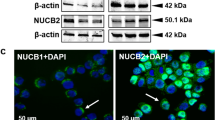Abstract
Reduction of mRNA expression from the endogenous GH gene by insulin-like growth factor 1 (IGF-1) in somatotroph-like rat MtT/S cells was measured. GH mRNA levels were reduced by 65 nMIGF-1 treatment in a time-dependent manner over 5 d of culture with a calculated GH mRNA half-life of 50 h, in line with previous values from primary cultures. Inhibition of inositol 3-phosphate kinase by wortmannin or LY-294,002 treatment was ineffective in blocking IGF-1 decreases in GH mRNA, as was inhibition of MAP kinase activity by PD 098059. The inhibition by IGF-1 also did not regulate Pit-1 (GHF-1) mRNA levels, which were constant during 65 nMIGF-1 treatment. MtT/S cells were shown to have both IGF-1 and insulin receptors as detected by Western blotting. There was also shown to be the suggestion of “hybrid” receptors containing different beta chains from each of these related heterotetrameric receptors. Analysis of the effects of IGF-1 and insulin on MtT/S cells showed that each reduced GH mRNA in a dose-dependent manner gave a calculated EC50 of 15.5 nM for IGF-1 and 0.6 nM for insulin, suggesting that the respective receptors for each hormone were activated. However, GH mRNA response to IGF-1 treatment was “ultrasensitive,” exhibiting a switch-like effect; below 10 nM IGF-1, there was no decline in GH mRNA, but then maximal reduction occurred at IGF-1 concentrations above 20 nM. The degree of this ultrasensitive effect was calculated from the Hill equation for cooperativity, with a Hill coefficient of −4.1, greater than the classic cooperativity exhibited by hemoglobin binding to oxygen. The ultrasensitive response was specific for IGF-1, as insulin did not display this effect. These results suggest that the response evoked by the IGF-1 receptor could act as a binary molecular switch controlling GH mRNA expression in somatotrophs.
Similar content being viewed by others
References
LeRoith, D., Adamo, M., Werner, H., and Roberts, C.T.J. (1995). In, Molecular endocrinology: basic concepts and clinical correlations. (Weintraub, B. D., ed.), New York: Raven Press.
Berelowitz, M., et al. (1981). Science 212, 1279–1281.
Yamashita, S., and Melmed S. (1987). J. Clin. Invest. 79, 449–452.
Yamashita, S. and Melmed, S. (1986). Endocrinology 118, 176–182.
Yamashita, S. and Melmed, S. (1986). Diabetes 35, 440–447.
Rosenfeld, R. G., Ceda, G., Wilson, D. M., Dollar, L. A., and Hoffman, A. R. (1984). Endocrinology 114, 1571–1575.
Rosenfeld, R. G., Ceda, G., Cutler, C. W., Dollar, L. A., and Hoffman, A. R. (1985). Endocrinology 117, 2008–2016.
Bach, M. A. and Bondy, C. A. (1992). Endocrinology 131, 2588–2594.
Jones, J. I., Clemmons and D. R. (1995). Endocr. Rev. 16, 3–34.
Webster, J., Prager, D., and Melmed, S. (1994). Mol. Endocrinol. 8, 539–544.
Yamamoto, K., et al. (1992). J. Biol. Chem. 267, 11,337–11,3343.
Xu, L., et al. (1998). Nature 395, 301–306.
Soto, J. L., Castrillo, J. L., Dominguez, F., and Dieguez, C. (1995). Endocrinology 136, 3863–3870.
Inoue, K., et al. (1990). Endocrinology 126, 2313–2320.
Nogami, H., et al. (1999). Endocrinology 140, 2763–2770.
Miller, T. L., Godfrey, P. A., Dealmeida, V. I., and Mayo, K. E. (1999). Endocrinology 140, 4152–4165.
Inoue, K. and Sakai, T. (1991). Exp. Cell. Res. 195, 53–58.
Niiori-Onishi, A., et al. (1999). Endocrinology 140, 344–349.
Yamashita, S., Ong, J., and Melmed, S. (1987). J. Biol. Chem. 262, 13,254–13,257.
Castillo, A. I. and Aranda, A. (1997). Endocrinology 138, 5442–5451.
Giustina, A. and Veldhuis, J. D. (1998). Endocr. Rev. 19, 717–797.
Yaffe, B. M. and Samuels, H. H. (1984). J. Biol. Chem. 259, 6284–6291.
Barinaga, M., Bilezikjian, L. M., Vale, W. W., Rosenfeld, M. G., and Evans, R. M. (1985). Nature 314, 279–281.
Morita, S., Yamashita, S., and Melmed, S. (1987). Endocrinology 121, 2000–2006.
Dasen, J. S. and Rosenfeld, M. G. (1999). Curr. Opin. Genet. Dev. 9, 566–574.
Soos, M. A. and Siddle, K. (1989). Biochem. J. 263, 553–563.
Soos, M. A., Whittaker, J., Lammers, R., Ullrich, A., and Siddle, K. (1990). Biochem. J. 270, 383–390.
Moxham, C. P., Duronio, V., and Jacobs, S. (1989). J. Biol. Chem. 264, 13,238–13,244.
Bailyes, E. M., et al. (1997). Biochem. J. 327, 209–215.
Soos, M. A., Field, C. E., and Siddle, K. (1993). Biochem. J. 290, 419–426.
Kasuya, J., et al. (1993). Biochemistry 32, 13,531–13,536.
Steele-Perkins, G., et al. (1988). J. Biol. Chem. 263, 11,486–11,492.
Melmed, S. and Yamashita, S. (1986). Endocrinology 118, 1483–1490.
Koshland, D. E., Jr. (1998). Science 280, 852–853.
Stryer, L., (1988). Biochemistry. New York: W. H. Freeman and Company.
Melmed, S., et al. (1996). Recent. Prog. Horm. Res. 51, 189–215.
Author information
Authors and Affiliations
Corresponding author
Rights and permissions
About this article
Cite this article
Voss, T.C., Mangin, T.M. & Hurley, D.L. Insulin-like growth factor-1 causes a switch-like reduction of endogenous growth hormone mRNA in rat MtT/S somatotroph cells. Endocr 13, 71–79 (2000). https://doi.org/10.1385/ENDO:13:1:71
Received:
Revised:
Accepted:
Issue Date:
DOI: https://doi.org/10.1385/ENDO:13:1:71




